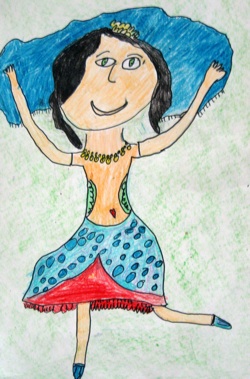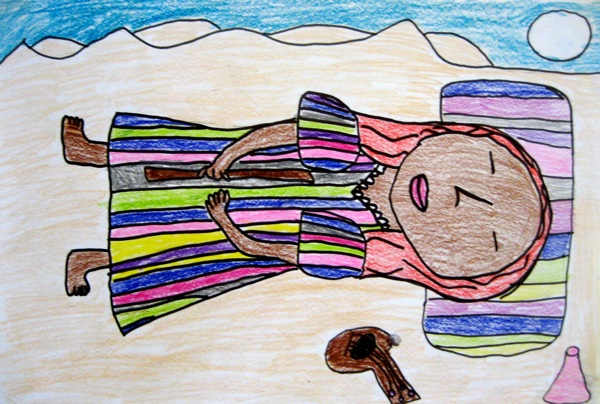
Colleen Vallerga’s Storyline® Resources for Teachers

A student’s drawing of Zemphira from the Living Art Museum Storyline
The Scottish Storyline Method is a worldwide innovative approach to learning with proven success over the past fifty years. It was developed by Sallie Harkness, Steve Bell, and Fred Rendell in Glasgow, Scotland 1965.
Storyline is based on the theory that all learning is guided by one’s prior knowledge and experience and that learners construct their own meaning through action and experience.
During a segment of each day, basic skills and curriculum are integrated into a meaningful context within a story. Through key questioning, the students are encouraged to construct their own models of what is being studied before testing them with real evidence and research. The key questions are used in a sequence that creates a context within the framework of a story.
Guided by the key questions, the learners and teacher create a setting, become characters, and solve problems within the context of the story as incidents unfold. A variety of art and craft techniques are employed. Over several months, students are given the opportunity to research, learn and reinforce basic skills in support of the developing Storyline .
Even though the teacher is planning a sequence of activities through the designing of key questions, he or she does not know the details of the content, because these are created by the students. Storyline is about process and not merely about content. Collaborative story making is the heart of Storyline. -Storyline Scotland
If you are new to the Storyline method and interested in becoming a Storyline teacher, it is important to take a Storyline class to gain an in-depth understanding of the method. Check out the Storyline Design website for class offerings.
Storyline Resources for Teachers
All resources offered on this website respect the integrity of Storyline by weaving story and curriculum together in a meaningful and educationally sound way.
Storyline manuals and Storyline outlines are available in PDF format on this website.
Storyline Manuals
The Storyline manuals contain a comprehensive outline, similar to the Storyline outlines. In addition to an outline of the Storyline, the manuals also contain an appendix with a calendar for the Storyline, writing/poetry lessons, developed incidents, examples of student work, homework, visuals, post tests, etc.
- The Living Art Museum
A Storyline by Colleen Vallerga - Gabriella’s Song
A Storyline by Colleen Vallerga - Knights of the Round Table
A Storyline by Colleen Vallerga - The People of the Longhouse
A Storyline by JJ Howard and Colleen Vallerga - Cycles
A Storyline by Colleen Vallerga - Voices from the Rainforest
A Storyline by Colleen Vallerga
Classroom Storyline Outlines
The Storyline outlines include episodes, key questions, activities, class organization, resources, standards and assessment. Each outline provides detailed instructions for comprehensive Storyline implementation.
- Monarch
A Storyline by Colleen Vallerga - The Museum of Wonders
A Storyline by Colleen Vallerga - The Red Bicycle
A Storyline by Colleen Vallerga - Weslandia
A Storyline by Colleen Vallerga - Circus Olympus
A Storyline by Colleen Vallerga - My Heart is a Compass
A Storyline by Colleen Vallerga - Old Rock
A Storyline by Colleen Vallerga - Eric Carle Land
A Storyline by Colleen Vallerga - Rewilding
A Storyline by Colleen Vallerga - Apple Pie
A Storyline by Colleen Vallerga - The Honeybee Man
A Storyline by Colleen Vallerga
ELD Storyline Outlines
Like the classroom outlines, the ELD outlines present the episodes, key questions, activities, class organization, resources, standards, and assessment. The standards covered in an ELD Storyline differ in that they are primarily language focused.
- The Honeybee Man
A Storyline by Colleen Vallerga and Caitlin Vallerga - Apple Pie
A Storyline by Colleen Vallerga and Caitlin Vallerga - The Land of Fairytales
A Storyline by Colleen Vallerga
Note: Teachers can adapt classroom Storylines for ELD use by shifting the curricular focus to a language study. Teachers can adapt ELD Storylines for classroom use by shifting the curricular focus to classroom standards.
It takes curricular knowledge, creative story making ability, Storyline experience, and a substantial amount of time to write a solid Storyline. All this has been done for you in the Storyline manuals and outlines.


